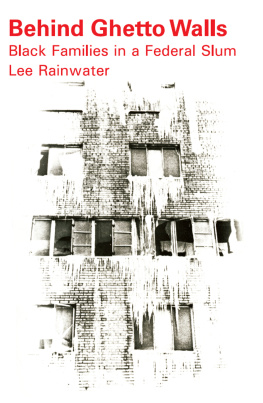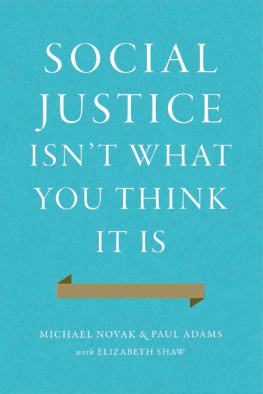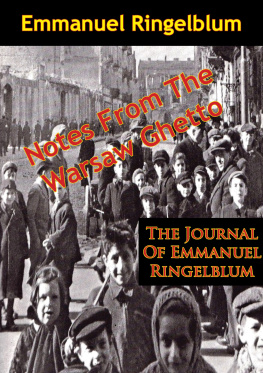To Carol
First published 1970 by Transaction Publishers
Published 2017 by Routledge
2 Park Square, Milton Park, Abingdon, Oxon OX14 4RN
711 Third Avenue, New York, NY 10017, USA
Routledge is an imprint of the Taylor & Francis Group, an informa business
Copyright 1970 by Lee Rainwater.
All rights reserved. No part of this book may be reprinted or reproduced or utilised in any form or by any electronic, mechanical, or other means, now known or hereafter invented, including photocopying and recording, or in any information storage or retrieval system, without permission in writing from the publishers.
Notice:
Product or corporate names may be trademarks or registered trademarks, and are used only for identification and explanation without intent to infringe.
Library of Congress Catalog Number: 2006045649
Library of Congress Cataloging-in-Publication Data
Rainwater, Lee.
Behind ghetto walls: black families in a federal slum / Lee Rainwater,
p. cm.
Originally published: Chicago: Aldine, [1970].
Includes bibliographical references and index.
ISBN 0-202-30907-X (alk. paper)
1. African AmericansSocial conditions1964-1975. 2. African AmericansSocial life and customs20th century. 3. African American families. 4. African AmericansMissouriSaint LouisSocial conditions20th century. 5. African AmericansMissouriSaint LouisSocial life and customs20th century. 6. African American familiesMissouriSaint LouisHistory20th century. 7. PoorMissouriSaint LouisHistory20th century. 8. Inner citiesMissouriSaint LouisHistory20th century. 9. Public housingMissouriSaint LouisHistory20th century. 10. Saint Louis (Mo.)Social conditions20th century. I. Title.
E185.86.R29 2006
305.56908996073077866dc22
2006045649
ISBN 13: 978-0-202-30907-1 (pbk)
The research on which this book is based began as a study of problems in a public housing project, Pruitt-Igoe in St Louis, and ended as a study of the dynamics of socio-economic inequality. The original principal investigators were concerned with what could be learned about the people in the project to assist the government agencies involved in developing more effective social welfare programmes. As the study developed, the principal policy concerns shifted towards questions involving the changes in the socio-economic system that would be necessary to eliminate the kinds of inequality from which the residents of Pruitt-Igoe suffer. These shifts in concern, and the consequent shifts in the kinds of data seen as important, mirror the basic change during the 1960s in the focus of social diagnosis. In the research process itself, this meant that instead of addressing the subjects of our research primarily as tenants in a public housing project, we came to be interested in them as lower-class black people, and even more generally as representative members of the American underclass, a group of many hues.
Throughout the book the people whose patterns of family life are discussed are referred to as Negro rather than by the recently fashionable terms black or Afro-American. The term black as the appropriate appellation for people who have traditionally been called Negroes represents a healthy infusion of directness and down-to-earthness in American race relations. However, the sociologist inust face the fact that the great majority of black people still refer to themselves as Negroes and prefer that name to the more militant black or Afro-American as well as to the old-fashioned coloured. Certainly during the period in which the bulk of the field work for this study was done roughly the summer of 1963 through 1966 few of the people in the Pruitt-Igoe housing project or the larger St Louis black community ever used black as a racial label in other than a negative way. This general situation was reflected in our data, where black was very rarely used as it is now used among militants and the informed black and white public.
Unfortunately, while the sophistication of social diagnoses of racial subjugation and socio-economic inequality was increasing during the 1960s, the political prospects for change in line with these diagnoses worsened. This worsening followed upon the buildup of the war in South-east Asia, then the development of a dead-end militant radicalism that seems now to serve principally the expressive goals of the young white elite and young aspirants to elite status, and finally the setting in of reaction and a repressive governmental stance as the nations war mentality provided new opportunity to the right wing.
In this context, the policy implications of the research developed in the last chapter of this book may strike the reader as navely optimistic in tone. My optimism is based on the conviction that the problems of inequality are solvable, that the often repeated notion that the poor will always be with us is an unnecessary indulgence in metaphysical pathos. To say that the problems of poverty and those aspects of the race problem closely connected with poverty are solvable by unremarkable governmental action does not of course mean that the problems will be solved. Here the issue is one of political will, courage, and commitment to the goal of equality. In these respects the beginning of the decade of the 1970s provides little room for optimism.
In writing this book I relied most heavily on the work of four of the field researchers and research associates who were involved in the Pruitt-Igoe research: Boone Hammond, Joyce Ladner, David Schulz, and Jerome Stromberg. As the reader will gather from the footnotes throughout the book, each of these persons has prepared his own analysis of one or another aspect of family behaviour in the Pruitt-Igoe project. Their analyses have appeared in the form of dissertations, articles, and books, and additional reports of their research will appear in the future. In a very real sense these four were direct collaborators in the enterprise recorded here. However, the particular formulation of the data presented in this book, the theoretical perspectives brought to bear, and the policy implications drawn are my responsibility, each of the four persons on whose work I have relied would disagree with some of my conclusions, and each has developed his own views in detail elsewhere.
Sociologists and anthropologists who rely on participant observation and conversational interviewing for their data on human life necessarily rely also on the interest, good will, and trust of the people they study. No group of people could have been more helpful, more open, and more frank about difficult reality than the residents of Pruitt-Igoe. They were as aware as anyone else that theirs is a story the world should not be allowed to forget, and many of them spent countless hours helping the university field workers learn enough to be able to tell that story like it is.
The personnel of the St Louis Housing Authority were understandably ambivalent about cooperating with the research team, but they cooperatively met our requests for data and information and facilitated our work where their help was needed. I particularly appreciate the assistance and the frankness and openness that I consistently found in my contacts with Irving Dagen, former executive director of the Authority.
Many persons worked as research assistants, field workers, and data analysts on the Pruitt-Igoe research. In addition to the four whose role was most central, I wish to thank William Fiegelman, Gwendelyn Jones, Martin Liebowitz, Colman Romalis, Ethyl Sawyer, Robert Simpson, Muriel Sterne, Lyle J. Woodyatt, and Martha and William Yancey. I thank all of them for giving me the opportunity to work with a remarkably stimulating and dedicated group of people.









